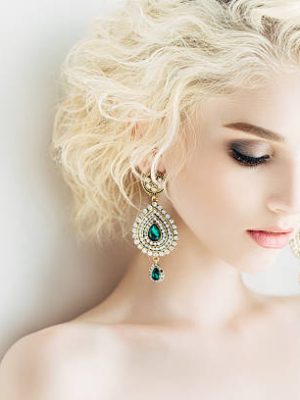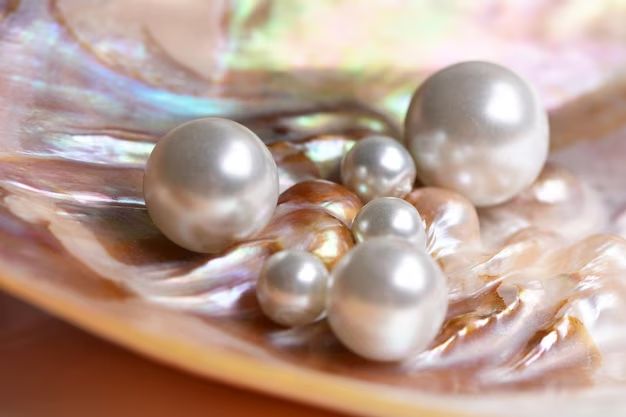
- Jewelry
Why South Sea Pearls Are the Ultimate Luxury: The Most Expensive Pearls Unveiled
Table of Contents
what variety of pearls are there?
Pearls have long been revered for their natural beauty and elegance. As one of the oldest and most cherished gemstones, they come in a variety of types, each with unique characteristics and charm. In this comprehensive guide, we’ll explore the main types of pearls—Akoya, freshwater, Tahitian, and South Sea—highlighting their distinct features, origins, and what sets them apart from one another.
1. Akoya Pearls
Origin and Cultivation: Akoya pearls are primarily produced in Japan, though they are also cultivated in China. The cultivation process involves the Akoya oyster (Pinctada fucata), which is known for its ability to produce pearls with a high luster. These pearls are typically farmed in coastal areas with clean, nutrient-rich waters.
Characteristics:
• Size: Akoya pearls are usually small, ranging from 6 to 8 millimeters, though some can reach up to 9 millimeters.
• Shape: They are often perfectly round, though slightly off-round shapes are also common.
• Luster: Akoya pearls are renowned for their brilliant luster, which gives them a mirror-like shine.
• Color: The most common colors are white and cream, but they can also be found in shades of pink, blue, and silver.
• Surface Quality: Akoya pearls generally have a smooth surface, but slight blemishes are not uncommon.
Notable Features: Akoya pearls are celebrated for their exceptional luster and classic appeal, making them a popular choice for traditional pearl jewelry, such as necklaces, earrings, and bracelets. Their refined elegance and relatively affordable price point contribute to their widespread popularity.
2. Freshwater Pearls
Origin and Cultivation:
Freshwater pearls are cultivated mainly in China, though they are also produced in other regions such as the United States and Japan. They are grown in freshwater mussels, primarily in lakes, rivers, and ponds. Unlike other types of pearls, freshwater pearls are often farmed in controlled environments to produce a range of shapes and sizes.
Characteristics:
• Size: Freshwater pearls vary significantly in size, ranging from 4 to 12 millimeters, with larger pearls being more rare.
• Shape: They come in a variety of shapes, including round, oval, baroque, and semi-baroque. Baroque freshwater pearls are particularly unique due to their irregular shapes.
• Luster: While freshwater pearls may not have the same intense luster as Akoya pearls, they still exhibit a pleasant sheen and a range of iridescent colors.
• Color: Freshwater pearls are available in a wide spectrum of colors, including white, pink, lavender, and peach. Some even have natural hues like blue and green.
• Surface Quality: Freshwater pearls can have a more varied surface texture, with natural imperfections and blemishes being more common.
Notable Features:
Freshwater pearls are appreciated for their versatility and affordability. Due to their wide range of colors and shapes, they offer more variety compared to other types of pearls. They are often used in fashion-forward designs and are ideal for those seeking unique and personalized pieces.
3. Tahitian Pearls
Origin and Cultivation:
Tahitian pearls are primarily cultivated in French Polynesia, specifically in Tahiti and surrounding islands. These pearls are produced by the black-lipped oyster (Pinctada margaritifera), which thrives in the warm, tropical waters of the South Pacific.
Characteristics:
• Size: Tahitian pearls are typically larger than Akoya and freshwater pearls, ranging from 8 to 14 millimeters, with some reaching up to 16 millimeters.
• Shape: While they can be round, Tahitian pearls are often baroque or semi-baroque in shape, adding to their distinctive appearance.
• Luster: Tahitian pearls are known for their deep, rich luster and unique metallic sheen.
• Color: They come in a wide array of colors, from classic black to deep greens, blues, and purples. The range of colors is due to the varying overtones and undertones in their natural hue.
• Surface Quality: Tahitian pearls generally have fewer surface imperfections than freshwater pearls but can still exhibit natural blemishes.
Notable Features:
Tahitian pearls are prized for their exotic appearance and bold colors. They are often considered more luxurious due to their size and unique color spectrum. Their rich, dark hues make them a popular choice for contemporary and high-end jewelry designs.
4. South Sea Pearls
Origin and Cultivation:
South Sea pearls are cultivated primarily in the warm waters of Australia, Indonesia, and the Philippines. They are produced by the white-lipped oyster (Pinctada maxima), which is known for its large size and the ability to produce some of the largest pearls in the world.
Characteristics:
• Size: South Sea pearls are among the largest pearls, typically ranging from 9 to 20 millimeters, with some exceeding this range.
• Shape: They are usually round or semi-round, but baroque shapes are also available. Their large size often results in a more pronounced shape.
• Luster: South Sea pearls are renowned for their exceptional luster and smooth, creamy finish.
• Color: They come in a variety of colors, including white, silver, gold, and champagne. The color often reflects the natural environment of the oyster.
• Surface Quality: South Sea pearls generally have high-quality surfaces with fewer blemishes due to the longer nacre layering process.
Notable Features:
South Sea pearls are considered one of the most prestigious types of pearls due to their size, luster, and rarity. They are often used in high-end jewelry and are prized for their opulent appearance and luxurious appeal.
Comparing the Different Types of Pearls
1. Luster and Shine:
Akoya and South Sea pearls are known for their exceptional luster, while Tahitian and freshwater pearls have a more varied luster. Akoya pearls offer a brilliant shine, while Tahitian pearls are appreciated for their metallic overtones.
2. Size and Shape:
South Sea pearls are the largest, followed by Tahitian pearls, with Akoya and freshwater pearls typically being smaller. Freshwater pearls offer a wide range of shapes, while Akoya pearls are often perfectly round.
3. Color Variety:
Freshwater and Tahitian pearls provide the broadest range of colors, with Tahitian pearls known for their dark, exotic hues and freshwater pearls offering pastel and vibrant shades. Akoya pearls are usually white or cream, while South Sea pearls come in white, gold, and champagne.
4. Price and Value:
Generally, South Sea pearls are the most expensive, followed by Tahitian, Akoya, and freshwater pearls. The price is influenced by factors such as size, luster, color, and surface quality.
5. Cultural and Historical Significance:
Each type of pearl has its own cultural significance. Akoya pearls are associated with classic elegance, freshwater pearls with versatility, Tahitian pearls with exotic luxury, and South Sea pearls with grandeur and opulence.
Caring for Different Types of Pearls
Regardless of the type, all pearls require careful maintenance to preserve their beauty. Here are some general care tips:
• Avoid Exposure: Keep pearls away from harsh chemicals, perfumes, and excessive sunlight.
• Cleaning: Clean pearls with a soft, damp cloth after wearing. Avoid soaking them in water or using abrasive cleaners.
• Storage: Store pearls in a soft cloth pouch or a lined jewelry box to prevent scratches and damage.
• Regular Checks: Have pearls checked by a professional jeweler regularly to ensure the integrity of the setting and the condition of the pearls.
Understanding the different types of pearls—Akoya, freshwater, Tahitian, and South Sea—can help you appreciate their unique qualities and make informed choices when purchasing pearl jewelry. Each type offers distinct characteristics in terms of size, shape, color, and luster, making pearls a versatile and timeless option for any jewelry collection.
Whether you’re drawn to the classic elegance of Akoya pearls, the unique beauty of freshwater pearls, the exotic allure of Tahitian pearls, or the luxurious grandeur of South Sea pearls, each type has its own story and charm. By exploring these differences, you can find the perfect pearl jewelry that reflects your personal style and taste.
Which Type of Pearl is the Most Expensive? Discover the Luxury of South Sea Pearls
When it comes to valuing pearls, several factors influence their worth, including type, size, luster, surface quality, and color. Among the various types of pearls—Akoya, freshwater, Tahitian, and South Sea—South Sea pearls generally hold the highest value. Here’s a closer look at why South Sea pearls are considered the most valuable:
South Sea Pearls: The Pinnacle of Pearl Luxury
1. Size and Rarity
• Size: South Sea pearls are renowned for their large size, typically ranging from 9 to 20 millimeters. Larger pearls are rarer and more sought after, contributing significantly to their higher value.
• Rarity: The size and quality of South Sea pearls make them less common compared to other types of pearls. Their rarity, combined with their large size, enhances their value.
2. Luster and Surface Quality
• Luster: South Sea pearls are known for their exceptional luster, which is often described as having a deep, silky, and smooth shine. This high-quality luster is highly valued in the jewelry market.
• Surface Quality: Due to the longer nacre development period in South Sea oysters, these pearls typically have fewer surface blemishes compared to other types. This high surface quality contributes to their premium status.
3. Color
• Color Range: South Sea pearls come in a variety of exquisite colors, including white, silver, and gold. The natural color of South Sea pearls is often rich and vibrant, which adds to their allure and value.
• Natural Overtones: The color and overtones of South Sea pearls are often more complex and appealing, which can enhance their desirability and price.
4. Production and Origin
• Origin: South Sea pearls are primarily cultivated in Australia, Indonesia, and the Philippines. The warm, clean waters of these regions are ideal for producing high-quality pearls.
• Cultivation: The process of cultivating South Sea pearls is labor-intensive and time-consuming. The pearls can take 2 to 4 years to form, during which time the oysters are carefully nurtured to ensure high-quality pearls.
Comparison with Other Pearl Types
While South Sea pearls are typically the most valuable, here’s a brief comparison with other types of pearls:
• Tahitian Pearls: Known for their unique dark colors and rich luster, Tahitian pearls are also highly valued but generally fall slightly behind South Sea pearls in terms of price. They are prized for their exotic colors and can be quite expensive, especially those with rare hues.
• Akoya Pearls: Akoya pearls are valued for their classic elegance and brilliant luster. While they are high-quality pearls, they are generally less expensive than South Sea pearls. Akoya pearls are more commonly available and typically smaller in size, which impacts their price.
• Freshwater Pearls: Freshwater pearls are the most affordable among the main types. They come in a variety of shapes and colors but generally lack the high luster and size of South Sea and Tahitian pearls. Their lower price reflects their more accessible and diverse production.
Conclusion
In the realm of pearls, South Sea pearls stand out as the most valuable due to their impressive size, exceptional luster, and rare color options. The combination of these factors, along with the meticulous cultivation process and their limited availability, makes South Sea pearls a premium choice for those seeking the highest quality and luxury in pearl jewelry. While Akoya, freshwater, and Tahitian pearls each offer their own distinct appeal and beauty, South Sea pearls remain the pinnacle of pearl opulence. Whether you’re an investor, a collector, or simply someone with a passion for fine jewelry, understanding the qualities that make South Sea pearls so valuable will help you appreciate their status as the most coveted pearls in the world.
Related Posts
Fall in Love with Jewelry, Stories, and Secrets
Join Artemies Magazine for insider jewelry tips, trend updates, and subscriber-only discounts.



